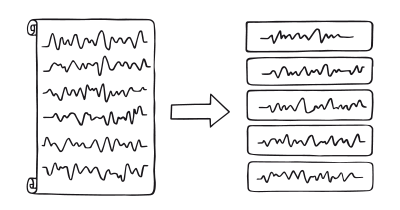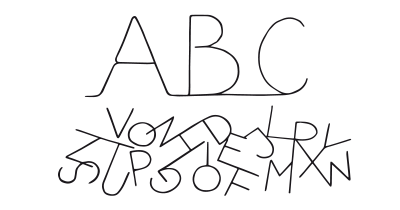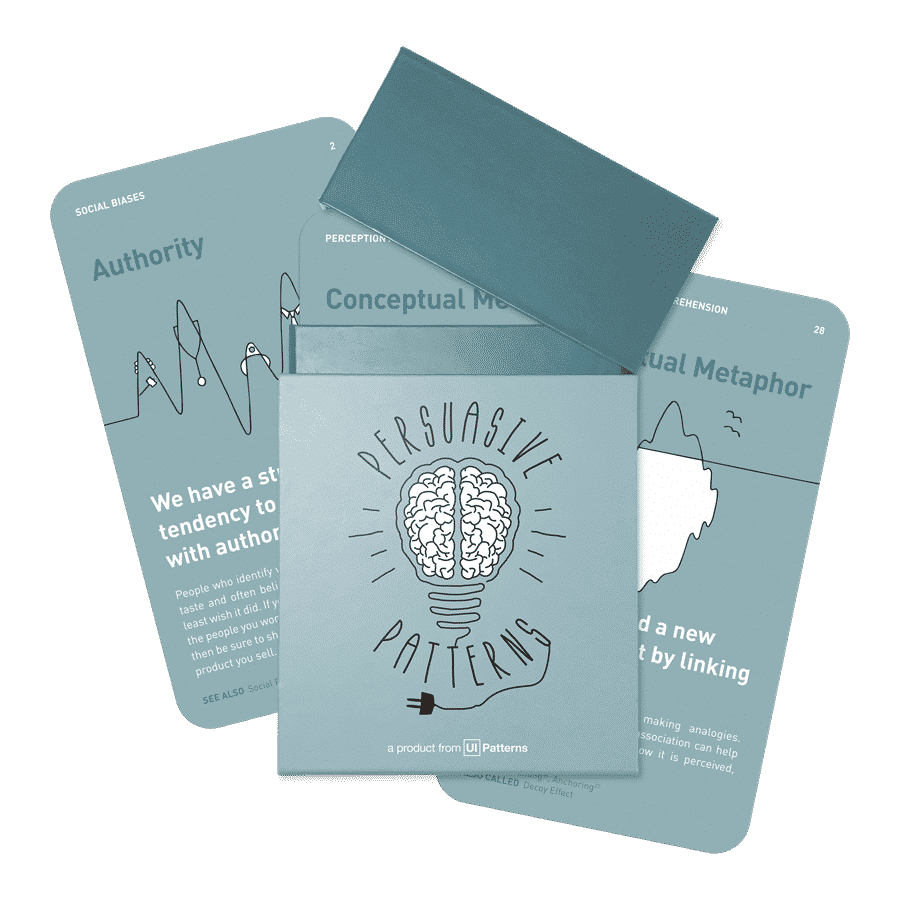Persuasive Technique
This persuasive pattern is part of the Persuasive Patterns printed card deck.
The Persuasive Patterns Card Deck is a collection of 60 design patterns driven by psychology, presented in a manner easily referenced and used as a brainstorming tool.
Get your deck!Chunking is the cognitive practice of breaking down information into smaller, manageable groups to facilitate easier processing and memory retention.
Imagine you’re at a networking event and someone you’ve just met tells you their phone number. Instead of trying to remember the entire 10-digit sequence, you naturally break it down into area code, first three numbers, and last four numbers. This makes it easier for you to recall the number later when you need to enter it into your phone. This is an example of chunking, where you’ve grouped the information into smaller, more manageable bits to facilitate memory retention.
Similarly, as you are entering your credit card information to make a purchase online, chunking can also help. Instead of presenting a single long input field for the 16-digit credit card number, the platform breaks it down into four separate fields, each accepting four digits. This design choice not only makes it easier for you to enter the information but also reduces the likelihood of making errors.
Similarly, you are using a project management software that has a long list of tasks you need to complete. Instead of displaying tasks in a random order, the software organizes them into categories like “Urgent,” “In Progress,” and “Completed.” This categorization, akin to chunking, helps you process the information more efficiently and prioritize your tasks better.
The magical number seven
One of the early studies that shed light on the power of chunking was conducted by psychologist George A. Miller in 1956. Miller’s research found that the number of objects an individual can hold in their working memory is about seven. This study didn’t just highlight the limitations of our memory; it also suggested a workaround. By breaking down information into chunks or groups, individuals could remember more. The study has had significant implications for various fields, including education and design, advocating for the segmentation of information to facilitate better understanding and memory retention.
Miller, G. A. (1956). The magical number seven, plus or minus two: Some limits on our capacity for processing information. Psychological Review, 63(2), 81–97.
The chunking technique has a profound impact in how we process and remember information. It is used to divide large or complex sets of information into smaller “chunks” that can be easily understood and remembered. This is based on the principle that our working memory has limited capacity. By grouping information into smaller units, we can process and remember it more effectively. The primary goal of chunking is to improve memory recall and comprehension, making it useful in a variety of contexts like learning, decision-making, and user experience design.
Chunking has been found to be a cost-effective strategy for producing and learning efficient movements, which can be particularly useful in interface design. It can also be applied in the design of educational materials to control cognitive load.
Chunking not only helps in recalling the chunked information but also improves the recall of non-chunked information. It further alleviates rehearsal demands and leads to improved working memory performance.
The technique of chunking is similar to sequencing, but with an important difference. Where sequencing is employed to break down complex tasks into a series of smaller, more manageable actions, chunking involves breaking down complex information or sets of data into smaller, more manageable groups. Chunking is primarily focused on aiding comprehension and memory. It doesn’t necessarily imply that the chunks must be addressed in a specific order. For example, when reading a manual, information might be chunked into sections by topic, allowing you to easily find and remember the information you need.
Designing products with Chunking
Chunking is not only an aesthetic choice; but primarily a functional one, aimed at enhancing the user’s ability to process and remember information.
Grouping similar items or features together can help simplify the user’s cognitive processing. When items are grouped by similarity or function, it surpasses the average limit of items that can be stored in working memory. The recommended range, according to Miller’s Law, is between three to seven items per chunk.
Adding visual cues like spacing, lines, or background colors can help distinguish between different chunks. This is particularly useful when dealing with long strings of numbers or text. For example, auto-formatting input fields can automatically group sections of credit card numbers or phone numbers, improving scannability while maintaining ease of input.
It’s essential to apply chunking only in contexts where it genuinely benefits the user’s cognitive process. Specifically, chunking should be employed when the user must memorize information or when an interface has to compete for a user’s attention amid multiple stimuli. For instance, in high-stress environments like emergency rooms, where health practitioners are bombarded with sensory information, effective chunking can significantly improve the usability of information systems.
Let’s look at examples of how chunking can help information processing:
- Phone numbers
1234567890 vs Chunked: (123) 456-7890 - Dates
27101992 vs 27-10-1992 - Financial Numbers
1000000000 vs 1,000,000,000 or 1 billion
Ethical recommendations
One possible misuse of chunking arises when it serves to overwhelm rather than simplify. For instance, if too much information is packed into individual chunks, users might find themselves in a state of information overload, counteracting the intended benefits of chunking.
Inconsistency in the application of chunking can be a concern. If similar items are chunked differently across various pages or sections, the inconsistency could add cognitive load to the user experience. Users might find it harder to locate what they need, thereby wasting time and increasing frustration.
Examples
Duolingo
Language learning is broken into smaller lessons and skills, aiding retention and reducing cognitive load.
Asana
In project management, Asana allows for tasks to be broken down into sub-tasks, making complex projects more manageable.
IKEA
The instruction manuals for their furniture use chunking by breaking down the assembly process into a series of individual steps, each clearly delineated with simple illustrations and minimal text. This helps the customer focus on completing one small task at a time.
Trigger Questions
- Are we overloading the user's cognitive capacity?
- How can we group similar items for better memorability?
- What visual cues can we employ to distinguish chunks?
- Are we applying chunking where it's most effective?
Pairings
Chunking + Pattern Recognition
Both chunking and pattern recognition deal with making information easier to process and remember. A good example is the smartphone app Duolingo, where language lessons are chunked into smaller modules and pattern recognition is employed to help learners identify common phrases or sentence structures.

We process and remember information grouped into manageable bits more easily

We try to recognize patterns even where there are none
Chunking + Limited Choice
When a user is faced with too many choices, chunking the choices into logical categories can work in tandem with limiting the number of choices to simplify decision-making. Amazon’s search results often do this by presenting products in chunks based on categories and limiting the number of choices visible at first glance.

We process and remember information grouped into manageable bits more easily

We are more likely to make a decision with fewer options to choose from
Chunking + Serial Positioning Effect
This refers to our tendency to remember the first and last items in a series best. Chunking the information with this in mind can lead to a better recall. In educational software, vital concepts are often placed at the beginning or end of modules to take advantage of this effect.

We process and remember information grouped into manageable bits more easily

We remember the first and last items in a list better
This persuasive pattern is part of the Persuasive Patterns printed card deck.
The Persuasive Patterns Card Deck is a collection of 60 design patterns driven by psychology, presented in a manner easily referenced and used as a brainstorming tool.
Get your deck!- The magical number seven by Miller
- The Magical Number Four in Short-Term Memory [ by Cowan
- How Chunking Helps Content Processing at Nielsen Norman Group
- Miller, G. A. (1956). The magical number seven, plus or minus two: Some limits on our capacity for processing information. Psychological Review, 63(2), 81–97.
- Bonhage, C. E., Fandakova, Y., Haussmann, S. B., Wolf, C., Kirste, I., & Werkle-Bergner, M. (2014). Chunking alleviates rehearsal demands and leads to improved working memory performance. Journal of Applied Research in Memory and Cognition, 3(4), 265-273.
- Dallal, N. L., & Meck, W. H. (1990). The application of a chunking strategy provides for more efficient use of working memory. Memory & Cognition, 18(6), 546-556.
- Thalmann, M., Souza, A. S., & Oberauer, K. (2019). Chunking benefits were found not only for recall of the chunked but also of other not-chunked information. Journal of Cognitive Psychology, 31(5-6), 582-606.
- Cowan, N. (2001). The magical number 4 in short-term memory: A reconsideration of mental storage capacity. Behavioral and Brain Sciences, 24(1), 87–114.
- Ericsson, K. A., Chase, W. G., & Faloon, S. (1980). Acquisition of a memory skill. Science, 208(4448), 1181–1182.
- Baddeley, A. (1992). Working memory. Science, 255(5044), 556–559.
- Paas, F., & Van Merriënboer, J. (1994). Instructional control of cognitive load in the training of complex cognitive tasks. Educational Psychology Review, 6(4), 351–371.
- Thaler, R. H., & Sunstein, C. R. (2008). Nudge: Improving decisions about health, wealth, and happiness. Yale University Press.
- LeCompte, D. C. (1999). Extending the “Magical Number 4±1”: The interplay of a central executive and other storage mechanisms. Cognitive Psychology.
- Ramkumar, P., Acuna, D. E., Berniker, M., Grafton, S., Turner, R. S., & Kording, K. P. (2016). Chunking as the result of an efficiency–computation tradeoff. Nature Communications, 7, 12176.
